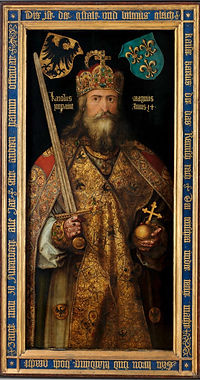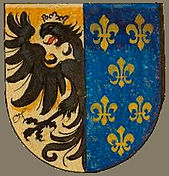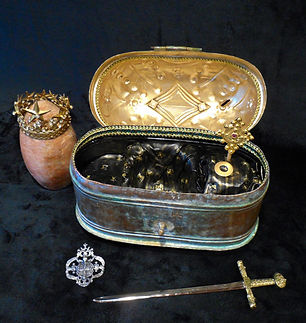
#9 - The Heart Stone of Charlemagne Keep



The Keep of:
The Sacred Heart Stone of Charlemagne
Born - 2 April 747
Died - 28 January 814 (age 66)

"Charles the Great"
Charlemagne
King of the Franks - 768 - 814
King of the Lombards - 774 - 814
Emperor of the Romans and the Carolingian Empire - 800 - 814
Born to Pepin the Short, King of the Franks, and Bertrada of Laon, Charlemagne has been called the "Father of Europe". After his father's death and his accession to the throne as King of the Franks, Charlemagne would unite most of Western Europe for the first time since the classical era of the Roman Empire and united parts of Europe that had never been under Frankish or Roman rule. With his expanse of the Frankish State, Charlemagne founded the Carolingian Empire. Charlemagne was crowned emperor in Rome by Pope Leo III to transfer the Roman Empire from east to west. The Carolingian Empire is considered the first phase in the history of the Holy Roman Empire,


which lasted until 1806. He was later canonized by Antipope Paschal III, but that was later treated as invalid, and he is now regarded as beatified, which is a step on the path to sainthood, by the mainstream Catholic Church. During his 47 years’ reign, there was trouble from just about every direction. Slavs, Avars, Moors, Vikings, Saxons – he had to defeat them all. He ended up fighting over sixty major battles to protect his kingdom and to make it larger. Charlemagne stands out for his many reforms: monetary, governmental, military, cultural and ecclesiastical. In January 814, he fell ill with pleurisy. In a deep depression he took to his bed on January 21 and died one week later. Charlemagne is buried at Aachen Cathedral in Aachen, Germany.
The Power of the Heart Stone
Throughout time, great power over the people and lands have been foretold in the stories and legends of old. King Arthur and the legend of the sword "Excalibur" is probably one of the best known. Legends have many key elements, an all-magical object for good, the uniting of people, a time of peace and prosperity and a story that stirs the imagination of man. Sacred items command a spirit of strength and purity of good for the common people. The "Heart Stone" is family to these sacred objects. It too is legendary to the rise of a great empire commanded by the Charlemagne. Whoever processes the "Heart Stone" has the power to rule over evil and one’s oppressors. It is the power of love and all things good. Those who hold the heart are revered and loved by all who encounter it. This was the power and the success of Charlemagne's reign.
The "Heart Stone" is a potassium aluminum silicate feldspar called moonstone. There are many colors of moonstone, and the heart stone is a peach moonstone. Some of the natural properties of peach moonstone are inner growth and strength, it teaches us the natural rhythms of life, opens the heart to empathy, and assists in the acceptance of love. It soothes emotional instability and stress, and stabilizes the emotions, providing calmness. Moonstone enhances intuition, promotes inspiration, success and good fortune in love.

The Heart Stone legend dates to the 5th century. It is said that the stone was found in the Jizera Mountains, what is now northern Czechia just east of Germany and south of the Poland border, by a poor wanderer named
Faramund I, whose soul was lost by the death of his dearest true love. Faramund found the stone at the base of a solitaire heat-shaped mountain in a deep fissure that emanated a warmth and peace that he had never felt before in his life. The stone was smooth with a flesh color, resembling a human heart. When he picked up the stone, a feeling of great peace and inner strength overwhelmed him. His anguish and loss of love was replaced by joy and purpose. Faramund returned to his people and homeland and immediately began helping others with the powers bestowed to him by his mountain find. Faramund will rule his people becoming the first great king of the Franks. Upon his death, the stone was lost until found by the Great Charlemagne.

It is not exactly known how Charlemagne came into possession of the Heart Stone, but he knew the powers that it processed, and used that power for his conquests and unification of different people. The Heart Stone was always in his presence and was revered by all. He housed the stone in a metal keep with embellishments and symbolism. The heart is placed center in the box with a fabric lined fitted form to hold it in place. To the left of the heart is a depiction of Charlemagne holding the Christian symbols of authority, the
Orb and Sceptre. Also on the left is the Crest design of his rule. On the right of the stone is the "Crown of Kingdom" which when removed is placed on the Heart Stone to show reverence. Inside the crown is a solid gold cross representing the Holy Power of the Catholic Pope. When the keep is closed, a replica sword of Charlemagne's, "Joyeuse", pierces the top of the box locking it in place. This is reminiscent of King Arthur's sword "Excalibur" piercing its stone entrapment. Charlemagne's original sword was used in French royal coronation ceremonies since the 13th century and is now kept at the Louvre museum.









"Joyeuse"
"Joyeuse"

